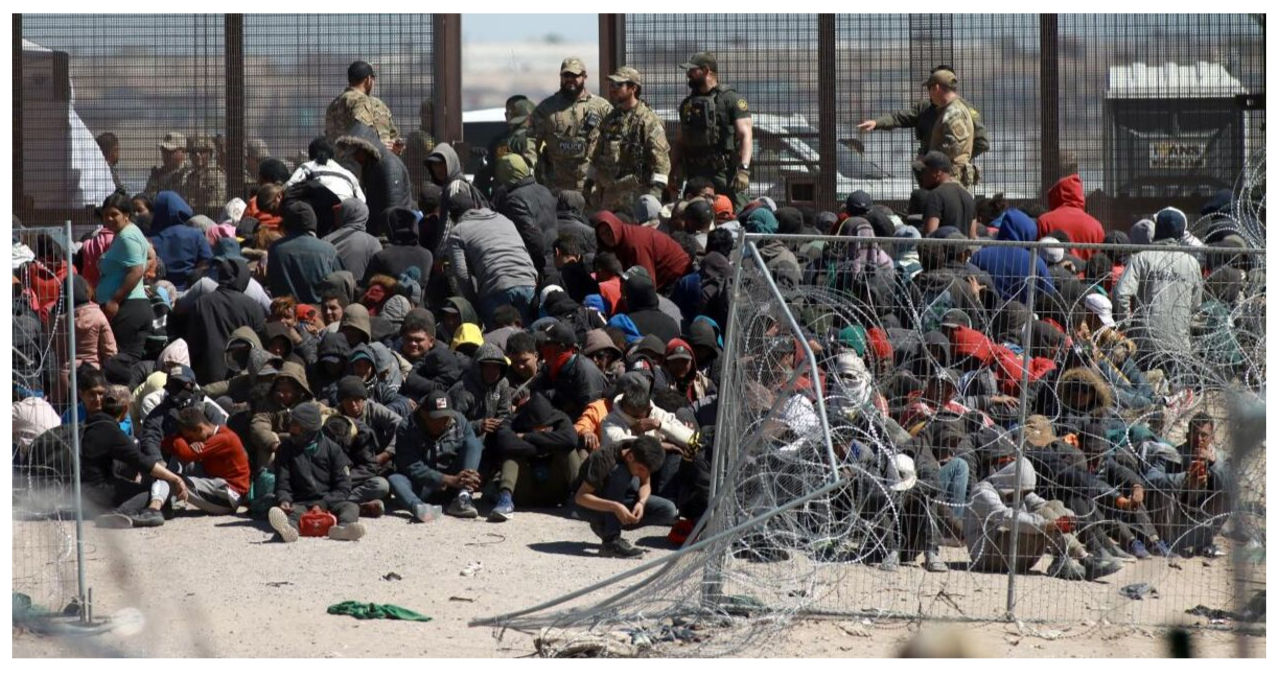Once upon a time, when migrants arrived in this region, they would journey across the Rio Grande and find their way to a gate in the border fence. At this point, they would willingly surrender themselves to federal agents in order to seek asylum.
Before, Gate 36 was a simple area. However, things have changed dramatically since Texas Gov. Greg Abbott stepped in. Now, this once peaceful zone has been transformed into a heavily fortified militarized zone. It is now guarded by armed soldiers, a fleet of Humvees, and a daunting display of razor wire that glimmers under the scorching desert sun.
As Mario Jesús Nazareño stood on the riverbank, his eyes scanned the landscape ahead. He couldn’t help but feel a sense of unease as he looked towards the north. “It resembles a prison,” he murmured, his voice filled with a hint of sadness.
After weeks of travel from his native Ecuador, the 47-year-old former boxer finally reached the border. His ultimate destination was Florida, where he had relatives waiting for him.
Now, he and hundreds of others found themselves in a predicament. The governor’s goal is to hinder migrants from reaching the gate, which is a section of the 30-foot high, steel border wall constructed during the Trump presidency. By doing so, he aims to prevent them from having the opportunity to apply for political asylum or seek other forms of relief that could potentially enable them to stay in the United States.
“We just want to surrender,” expressed David Arau, a 33-year-old Venezuelan resident who embarked on a months-long journey from his home in the north. “Unfortunately, the army is preventing us from doing so.”
Another day passed at Gate 36, where the standoff continued.
The federal government has traditionally been responsible for immigration enforcement, but Texas is now challenging this authority amidst a surge of migrants at the U.S. southern border.
Abbott has been intensifying his efforts with “Operation Lone Star,” a crackdown that he initiated three years ago, employing National Guard troops and state police to discourage illegal immigration and narcotics smuggling. This initiative not only serves as a means to address these issues but also as a way to highlight what he perceives as the Biden administration’s inability to effectively manage border control.
The Texas governor has been attempting to implement a law called S.B. 4, which was passed last year. This law would grant state and local authorities the power to detain immigrants solely for being in the country illegally. The 5th Circuit Court of Appeals, which recently placed a temporary hold on the law, is set to hear arguments in the case in the coming weeks.
The White House argues that the statute is unconstitutional and infringes on federal authority. This argument is expected to be brought before the Supreme Court.
The legal battle is currently unfolding at a time when the border has become a significant campaign issue in this election year.
In demonstrating Abbott’s increasingly stringent approach, one need only observe Gate 36. It was at this location that Abbott initially deployed National Guard soldiers and state police in late 2022.
Last week, Texas troops clashed with scores of migrants, who managed to break through the militarized zone at Gate 36. They eventually surrendered to the Border Patrol. Following this incident, Abbott confidently declared that his units had successfully sealed the breach.
“The Texas National Guard and Department of Public Safety swiftly regained control and are reinforcing the razor wire barriers,” Abbott stated on X. “The DPS has been directed to apprehend each and every illegal immigrant involved for the crimes of criminal trespass and destruction of property.”
A group of heavily armed soldiers in riot helmets faced off against a disheveled group of individuals attempting to cross the border. These border crossers had set up camp on the littered U.S. side of the Rio Grande, their numbers dwindling. Makeshift tents, consisting mostly of blankets and sheets strung from wooden poles, stretched for hundreds of yards between the water and the razor wire.
A few yards away, construction equipment exerted force to install fresh segments of fencing. A megaphone echoed a recorded message, cautioning migrants about the potential consequences of damaging the razor wire, including the possibility of arrest.
Border Patrol officials have stated that despite the tensions between the Biden administration and the Texas governor’s office, there is close coordination between federal and state authorities at Gate 36 and other locations. While Operation Lone Star is a state initiative, the Border Patrol is present and actively cooperating with the state authorities. One Border Patrol official, who requested anonymity because they were not authorized to speak publicly, emphasized the ongoing collaboration.
Many migrants have embarked on a transcontinental journey, traveling for months from South America and beyond. They have traversed oceans, jungles, mountains, cities, and deserts, all in pursuit of reaching Gate 36. In fact, some of them had already heard of Gate 36 long before they even arrived at their destination.
Migrants constantly move in and out of the camp, leaving behind traces of their presence: a toothbrush, a pair of spectacles, a faded ID card, a handwritten letter, and shreds of clothing clinging to barbed wire and bushes like tattered Christmas ornaments.
Migrants do not have access to toilets or clean water. In order to purchase food, water, and other essential items, they have to dash across a six-lane highway to reach an Oxxo convenience store.
“I never expected this place to be so dreadful,” expressed Lisbeth Carrillo, a 31-year-old traveler accompanied by her daughters, María, 15, and Cirielis, 5, who are among the numerous children residing in the camp.
Carrillo, a former beauty shop owner from Venezuela, confidently asserted, “However, we will patiently bide our time until we can safely make our way across.”
During their epic journey from Venezuela to the United States, she and her companions embarked on a challenging hike through the dense jungle wilderness known as the Darién Gap, situated between Colombia and Panama. However, they unanimously agreed that the most arduous stretch of their 3,000-mile expedition was the section that took them through Mexico. In this treacherous territory, migrants face numerous obstacles, including encounters with corrupt police officers, petty criminals, cartel members, and Mexican immigration agents who not only detain them but also frequently deport them back to southern Mexico.
Carrillo, with his black shirt torn at the back while attempting to crawl through Texas’ razor wire barrier, confidently stated, “The Darién may be challenging, but it is nothing compared to Mexico. In Mexico, one never knows what might happen.”
In January, there was a notable decrease in migrant detentions in various important crossing zones in Texas, with a significant rise observed in the San Diego and Tucson areas. Governor Abbott has taken credit for this shift in the detention numbers.
“Our strong resistance is proving effective,” stated the governor in a recent post on X. “Texas remains committed to standing firm.”
Experts caution that it is premature to attribute this shift in migration patterns to any specific reasons. Migrants regularly communicate with each other through group chats, sharing information on changes in U.S. immigration strategies. Historical crackdowns have frequently resulted in migrants moving towards increasingly remote regions of the border. Unfortunately, this has often led to a rise in migrant fatalities in deserts, mountains, and other secluded areas.
According to Panamanian officials, the number of people crossing the Darién Gap has significantly increased in the first two months of 2024. More than 73,000 individuals have made this journey, which is almost 50% higher compared to the same period last year. It is worth noting that in 2023, a record-breaking half a million people traveled northbound through the Darién Gap. The majority of these migrants have a common destination in mind: the United States.
Many migrants who arrive at the U.S. border have intentions to apply for political asylum, although a significant number of them admit that they are seeking better economic opportunities rather than escaping persecution. Due to the immense backlog in immigration courts, asylum seekers are often allowed into the country and have to wait for more than two years for their court dates.
The continued influx of migrants indicates that the standoff at Gate 36 is unlikely to come to an end anytime soon.
On Sunday morning, amidst a swirling dust storm, a large group of migrants made a daring escape from the camp. Undeterred by the challenges that lay ahead, they skillfully maneuvered under the razor wire coils or cut through them, making their way towards the steel wall. With Border Patrol agents prepared for their arrival, the migrants raced approximately 50 yards to reach their potential salvation.
As fresh arrivals hitched rides on freight trains to reach Ciudad Juárez, they quickly replaced those who had lined up along the border fence. These newcomers wasted no time in claiming the deserted tents and blankets left behind by previous camp residents.
Yender Arrieta, a 26-year-old Venezuelan migrant who has been traveling for two months, expressed his determination to continue forward, stating, “One thing is certain: We have come this far, we cannot turn back to Venezuela. We will find a way to reach our destination eventually.”
His sister, three nephews, an uncle, and an aunt were all huddled under blankets, nodding in agreement as a fierce wind blew a blinding dust.



